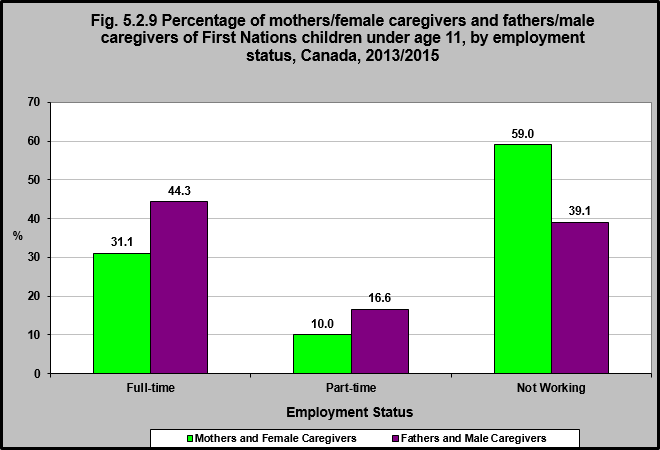Percentage of mothers/female caregivers and fathers/male caregivers of First Nations children under age 11 by employment status, Canada, 2013/2015

Source: CICH graphic created using data adapted from First Nations Information Governance Centre, Our Data, Our Stories, Our Future: The National Report of the First Nations Regional Early Childhood, Education and Employment Survey. 2016. http://fnigc.ca/sites/default/files/docs/fnigc_fnreees_national_report_2016_en_final_28072016_0.pdf -accessed August 25, 2017.
In 2013/2015, 41.1% of mothers/female caregivers and 60.9% of fathers/male caregivers of First nations children under age 11 were employed full-time or part-time.
59% of mothers/female caregivers and 39.1% of fathers/male caregivers were not working.
Of those not working, 73.6% of mothers/female caregivers were stay at home parents, 9.7% were looking for work, 9.2% were students and 2% were on maternity leave.1
For fathers/male caregivers, 39% were stay at home parents, 30.1% were looking for work and 12.2% indicated they work seasonally.1
1First Nations Information Governance Centre, Our Data, Our Stories, Our Future: The National Report of the First Nations Regional Early Childhood, Education and Employment Survey. 2016. http://fnigc.ca/sites/default/files/docs/fnigc_fnreees_national_report_2016_en_final_28072016_0.pdf-accessed August 25, 2017.
Implications
Mothers/female caregivers are most often the primary caregiver for children and are more likely to choose to be unemployed or employed in only a part-time capacity due to their child care responsibilities. In this context, the low rates of full-time employment and lack of employment opportunities for First Nations fathers/male caregivers is particularly concerning for the health and well-being of First Nations families, as lack of employment is associated with poverty, food insecurity, and mental health issues.
